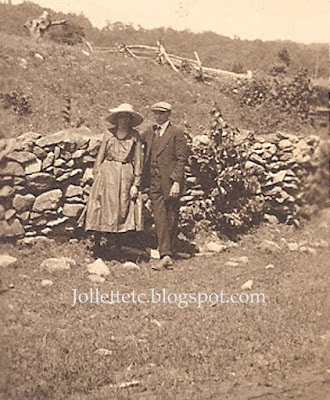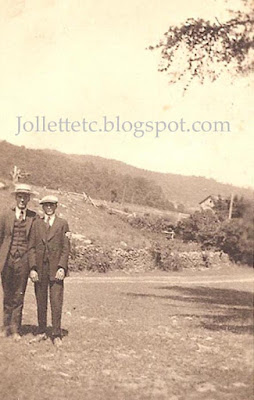Sepia Saturday challenges bloggers to share family
history through old photographs.
This week’s Sepia Saturday prompt depicting a young boy
watering his garden left me discouraged. That is because three years ago I shared
my only story of a watering can and children tending their garden. But I did
not worry long. After all, I have photos of rock walls.
Unfortunately, I have no story to go with them. They are just
simple photos of my grandaunt Violetta Davis (later Ryan), a cousin I
recognize, and men that I don’t.
While Violetta did not extend me the courtesy of labeling
names or location, she did include the date on every single one of these
photos: June 29, 1919. Amazing - just a couple weeks shy of 98 years ago that
Violetta and her friends went wherever they went to do whatever they did.
It was a Sunday. What was going on in the world?
The Treaty of Versailles was signed the day before,
bringing “the Great War” to an end. Big news day! Throughout the United States,
newspaper headlines read much like the one in the New York Times.
In other cities, the peace treaty took second billing to
news that the liquor ban would not be lifted.
In Leavenworth, Kansas, reports about the signing, the
German outrage, and the liquor issue took equal billing along with stories
about a drunk driver and about a prisoner who made a daring escape from the
Leavenworth jail disguised as a soldier.
The forging of world peace was not the only
headline-grabber that day. Still above the fold was the announcement of states
voting to ratify the 19th Amendment granting women the right to vote.
It would be another year before the required 2/3 majority of states ratifying
was achieved.
Those were exciting times. And on that day, my grandaunt
was just standing by a rock wall.
 |
| Violetta (left) and possibly her cousin Leota Sullivan 29 June 1919 |
Knowing my grandaunt Violetta the way that I did, I am positive no one was more excited about being able to vote than she was even though she was only 16 when the amendment was ratified. Violetta was a liberated woman long before women burned their bras. She preached the importance of girls getting an education and being able to make their way in the world without having to rely on a man for money.
 |
| Violetta as a student 1922 Harrisonburg Teachers College |
Don’t just stand there. There is more to read above the
fold at Sepia Saturday.
Wendy
© 2017, Wendy Mathias.
All rights reserved.









You went 'outside the box' connecting headlines with rock walls and your post was truly 'food for thought' in how one might make something rather interesting when one thought one had nothing to begin with. Well done!!! :)
ReplyDeleteNow I feel better about this flimsy post. Thanks!
DeleteA very inventive post. I liked the way you linked the date of the photographs with what was happening in the wider world. That is something I often do when writing my family history, but it had never occurred to me with Sepia Saturday posts. I must admit too that the stone walls had never struck me as a significant point in the prompt photograph. Cue for me to be more observant!
ReplyDeleteFunny you didn't notice the wall -- you're the champ of noticing things that I miss.
DeleteThe world needed more Violetta's during that time; but glad she was an advocate for women and their rights.
ReplyDeletebetty
She was that and more!
DeleteI enjoyed today's post and the one from three years ago. I must have seen it before but it was like reading a new post.
ReplyDeleteI know what you mean. I can barely remember my own, so if anyone recycles an old post, I'm sure it will feel brand new to me.
DeleteI enjoyed both posts, and I agree that the idea of linking the date of the photo to the newspaper articles is a novel one; unfortunately I have very few photos labelled at all, let alone with dates.
ReplyDeleteI have a fair number with a year but very few with a specific date. The Davis sisters were better at that than aunts on the other side of the family.
DeleteExcellent read! Learning how that one day carried so much real news of history compared to today's blathering on about who said what to whom and where...I'm very impressed. And newspapers were so much more the source of real news, rather than what happens today on various screens. Just my opinion... Thanks!
ReplyDeleteMy opinion too. I did find it amusing to read how miffed the Germans were at the signing. That's not the history I learned in school.
DeleteGreat blog post, as always!
ReplyDeleteOh thanks.
DeleteThis shows me a side to Violetta that before I would have imagined her sitting next to a radio listening to the current events. Instead she's out and about with friends taking pictures. Should we photoshop in a cellphone and a selfie shot?
ReplyDeleteAs fun and interesting as she was to talk to, I find it hard to imagine her out being free and frivolous and young
DeleteGreat approach to the prompt. I did a search on the date of one of my photos and it revealed a lot about my father. I wish I had the time to get the context of them all...but it would take all my time. I always enjoy reading you.
ReplyDeleteOh stop!
DeleteI love this creative post - you always find a way to bring your post around to the prompt. Interesting that Violetta put the dates on the photo but not the names. Don't you sometimes just want to slap our ancestors? :-)
ReplyDeleteNot sometimes - ALL the time!
DeleteThose dates written onto the back of a photo can be as important as a name. June 29, 1919 was indeed a momentous day. A lot of tragic events can be traced as consequences of that day. Recently I've started to read an excellent history of the post WW1 era, "Paris 1919: Six Months that Changed the World" by Margaret MacMillan. Woodrow Wilson had the heart of a zealot but failed to convince his fellow world leaders that peace could be achieved with democracy over retribution.
ReplyDeleteIncorporating front pages of newspapers was a fun and interesting twist on the SS theme, Wendy. And I'm still in awe of all the old family photographs you have!
ReplyDelete